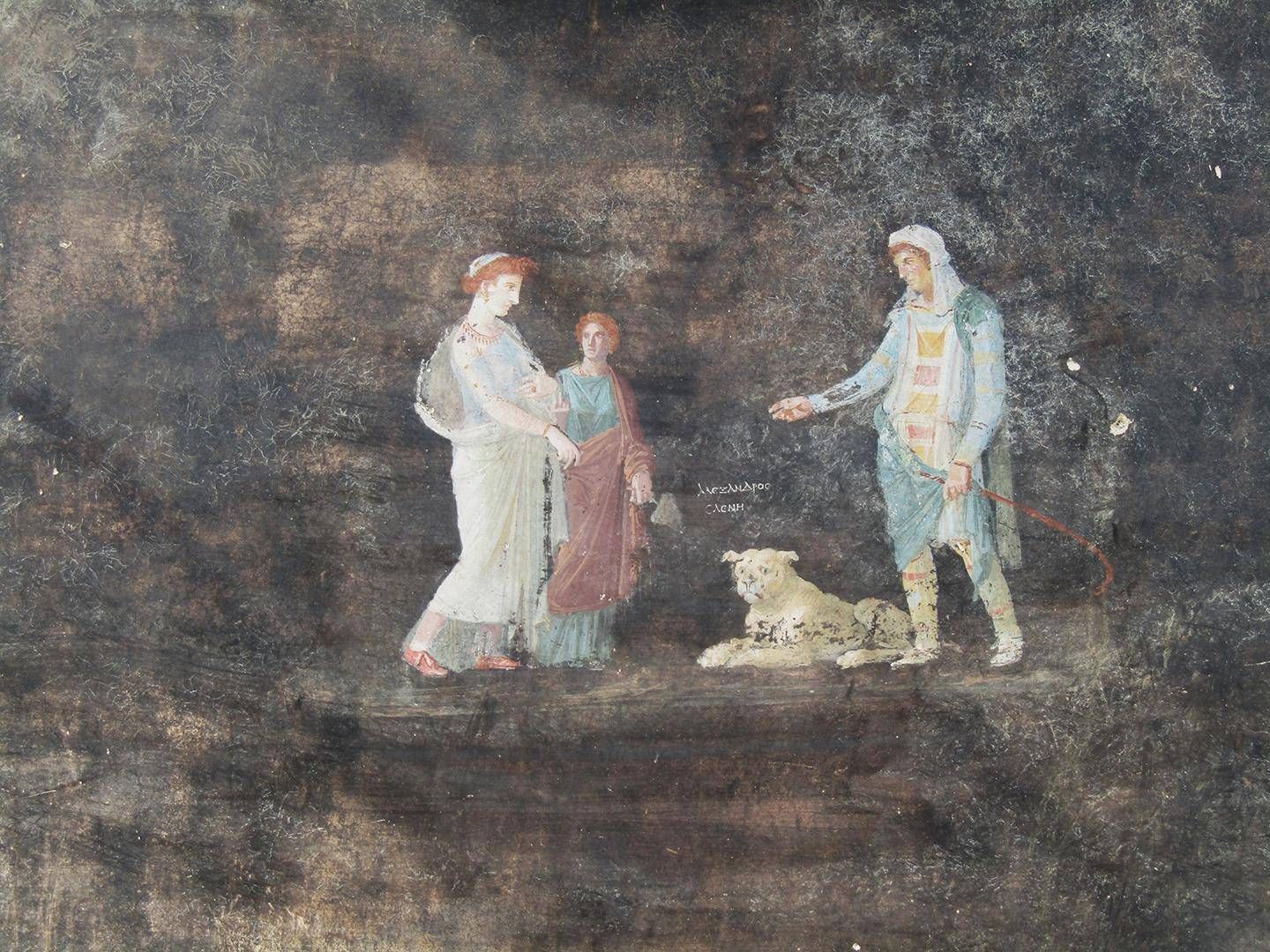An imposing banquet hall, with elegant black walls, decorated with mythological subjects inspired by the Trojan War, is the latest discovery in Pompeii: it emerged from the rooms recently brought to light during the excavation activities underway in insula 10 of the Regio IX and today completely visible in all its majesty. The announcement of the new discovery was made by the Ministry of Culture.
A refined environment in which to spend convivial moments, between banquets and conversations, in which one could breathe the high standard of living demonstrated by the spaciousness of the space, the presence of frescoes and mosaics dating back to the III style, the artistic quality of the paintings and the choice of subjects. The dominant theme seems to be that of heroism, for the depictions of couples of heroes and divinities of the Trojan War, but also of fate and at the same time the possibility, often not grasped, that man has of being able to change his own destiny .
In addition to Helen and Paris, indicated in a Greek inscription between the two figures with his other name ‘Alexandros’, the figure of Cassandra, daughter of Priam, paired with Apollo appears on the walls of the hall. In Greek mythology Cassandra was known for her gift of foresight and her terrible fate that prevents her from changing the future. Despite her ability to see beyond the present, no one believes her words, due to a curse that Apollo inflicts on her for not giving herself to him, and therefore she will not be able to prevent the tragic events of the Trojan War, which she had predicted. After being raped during the capture of Troy, she will end up as Agamemnon’s slave in Mycenae. The frequent presence of mythological figures in the paintings of living and convivial environments of Roman homes had the social function of entertaining guests and diners, providing ideas for conversation and reflection on existence.
“Pompeii is truly a treasure chest that never ceases to surprise us and arouse amazement because, every time we dig, we find something beautiful and significant. We believe in this global unicum that represents Pompeii and for this reason in the Budget Law we have financed new excavations. We must move forward in the protection of this important site but also in its valorisation”, commented the Minister of Culture, Gennaro Sangiuliano.
The director of the Archaeological Park of Pompeii, Gabriel Zuchtriegel, goes into detail about the discovery of the new premises: “The walls were black to avoid seeing the smoke from the lamps on the walls. Here we gathered to feast after sunset, the light flickering of the lamps made the images seem to move, especially after a few glasses of good Campania wine. The mythical couples were ideas for talking about the past and life, only apparently of a purely amorous nature. In reality, they talk about the relationship between the individual and destiny: Cassandra who can see the future but no one believes her, Apollo who sides with the Trojans against the Greek invaders, but despite being a God is unable to ensure victory, Helen and Paris who with their politically incorrect love are the cause of the war , or perhaps just a pretext, who knows. Today, Helen and Paris are all of us: every day we can choose whether to care only about our intimate life or to investigate how this life of ours is intertwined with great history, thinking for example, in addition to wars and politics, to the environment, but also to the human climate that we are creating in our society, communicating with others live and on social media”.
The hall measures approximately 15 meters long by 6 meters wide and opens into a courtyard which appears to be an open-air service hallway, with a long staircase leading to the first floor, devoid of decoration. Under the arches of the staircase an enormous pile of construction material was found set aside. Someone had drawn in charcoal on the rough plaster of the arches of the great staircase, two pairs of gladiators and what appears to be an enormous stylized phallus.
The excavation activity in insula 10 of Regio IX is part of a broader project to secure the perimeter front between the excavated and non-excavated area, to improve the hydrogeological structure, aimed at ensuring the protection of the vast Pompeian heritage (more than 13 thousand rooms in 1070 housing units, in addition to public and sacred spaces) more effective and sustainable.
The excavation in the area so far has yielded two houses connected to each other, a house with a bakery and a fullonica (laundry), which overlooked Via Nola and whose facades were already brought to light at the end of the 19th century. Behind these two houses, sumptuous frescoed living rooms are emerging in this phase of excavation, also in this case affected by major renovations at the time of the eruption.
The general director of the MiC Museums, Massimo Osanna, states: “The excavation in Regio IX, designed as part of the Great Pompeii Project and carried out under the direction of Gabriel Zuchtriegel, is the demonstration of how a well-done excavation in the Vesuvian city can continue to increase knowledge of one of the most important places that has come down to us from antiquity. New and unpublished paintings, new data on the enormous construction site that was Pompeii at the time of the eruption, new discoveries on the economy and forms of production. An extraordinary mass of data that is changing the image codified until now of the ancient city. A round of applause to the entire interdisciplinary team that is carrying out the research with passion and professionalism.”
